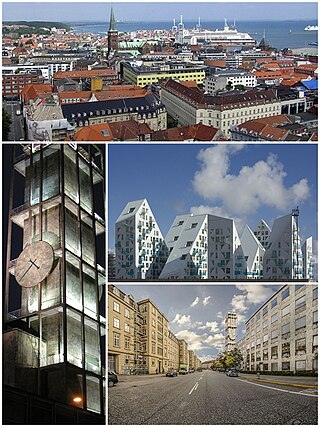
Aarhus is the second-largest city in Denmark and the seat of Aarhus Municipality. It is located on the eastern shore of Jutland in the Kattegat sea and approximately 187 kilometres (116 mi) northwest of Copenhagen.

Odder is a town in Jutland, Denmark. The town is the seat of Odder municipality, and is the biggest town in the municipality. It is located 20 km south of Aarhus and 16 km south-east of Skanderborg.

Aarhus University is a public research university with its main campus located in Aarhus, Denmark. It is the second largest and second oldest university in Denmark. The university is part of the Coimbra Group, the Guild, and Utrecht Network of European universities and is a member of the European University Association.

Billund is a town in Jutland, Denmark. With a population of 7,049, Billund is the second largest town in Billund Municipality, behind the municipal seat of Grindsted. It is located approximately 13 kilometers east of Grindsted and 27 kilometers west of Vejle.

The rail transport system in Denmark consists of 2,633 km of railway lines, of which the Copenhagen S-train network, the main line Helsingør-Copenhagen-Padborg, and the Lunderskov-Esbjerg line are electrified. Most traffic is passenger trains, although there is considerable transit goods traffic between Sweden and Germany.

Aarhus Stadium is an association football stadium in Aarhus, Denmark which has been the home ground of Aarhus Gymnastikforening since the 1920s. With a current capacity of 19,433, it is the third largest football stadium of any football team in Denmark. It is part of the sports complex, known as Aarhus Sports Park, that is run by Ceres Park & Arena.
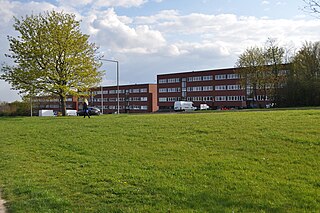
Lystrup is a suburb to Aarhus, Denmark. It is located 10 km north of Aarhus city centre, west of Egå and the Bay of Aarhus. It had a population of 10,213, and is the second most populous urban area of Aarhus Municipality.

Malling is a village in Denmark, located about 12 km (7.5 mi) south of Aarhus. It has a population of 6,194 (Jan 1, 2020).
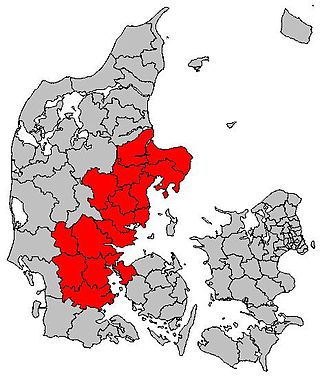
East Jutland metropolitan area is a potential metropolitan area in Jutland and Funen, Denmark. Aarhus is the most populated city in the region.

Mårslet is a railway town in Denmark, located about 11 km (6.8 mi) south of Aarhus. It has a population of 5,162. Mårslet is located in Aarhus Municipality and therefore is part of the Central Denmark Region.
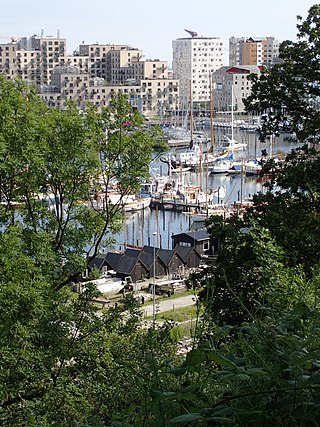
Aarhus Docklands is a new neighbourhood and construction site in Aarhus, Denmark.

The architecture of Denmark has its origins in the Viking period, richly revealed by archaeological finds. It became firmly established in the Middle Ages when first Romanesque, then Gothic churches and cathedrals sprang up throughout the country. It was during this period that, in a country with little access to stone, brick became the construction material of choice, not just for churches but also for fortifications and castles.

Næstved is a town in the municipality of the same name, located in the southern part of the island of Zealand in Denmark.

The Aarhus Letbane is a light rail system in the city of Aarhus, Denmark. It is operated by the company Midttrafik. The first line opened in December 2017, but the system is under continuous development and expansion. Service on the intercity section Odder to Lisbjergskolen opened on August 25, 2018. A third intercity line to Grenå opened on 30 April 2019. More lines are being planned.

Godsbanen is a cultural centre in central Aarhus, Denmark since 2012. The site and most of the buildings are a former goods station, known as "Aarhus Godsbanegård", which was in use from 1923 to 2000. It is located at the end of a broad sidetrack to the central railway yard of Aarhus. In December 2010, Realdania announced that the area would be gradually transformed into a modern city district, through a collaborative project with Aarhus Municipality. Apart from the new cultural centre of Godsbanen, there are plans to build several buildings and institutions along the former railway yard, including a new school of architecture.

The first high-speed railway in Denmark was the Copenhagen–Ringsted Line, completed in late 2018 and opened in 2019. Further high-speed lines are currently under planning.

Elev is a small town in Aarhus Municipality, Central Denmark Region in Denmark with a population of 1,821.
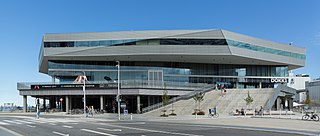
Dokk1 or Dokken is a government building, public library and culture center in Aarhus, Denmark. It is situated on Hack Kampmanns Plads in the city center by the waterfront next to the Custom House. Dokk1 is part of the much larger development project Urban Mediaspace Aarhus, jointly financed by Aarhus Municipality and Realdania for 2.1 billion DKK. It is designed by Schmidt Hammer Lassen Architects and Kristine Jensen, with construction managed by NCC AB. Construction broke ground 8 June 2011 and the building was inaugurated four years later on 20 June 2015.

The architecture of Aarhus comprises numerous architectural styles and works from the Middle Ages to present-day. Aarhus has a well-preserved medieval city center with the oldest dwellings dating back to the mid-1500s and some ecclesiastical structures such as St. Clemen's Cathedral and numerous smaller churches that can be traced back to the 1100s. The industrialization of the 19th and 20th centuries left distinctive industrial structures, important National romantic works and some of the best examples of Functionalist architecture in the country. The history of the city as a Viking fort is evidenced in the street layout of the Latin Quarter, the wider Indre By neighborhood testifies to its later role as a Market town and center of commerce while the Frederiksbjerg, Trøjborg and Marselisborg districts showcase the first cohesive urban planning efforts of the early 20th century.






















